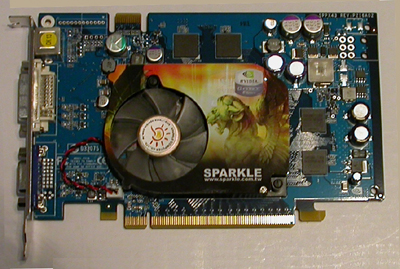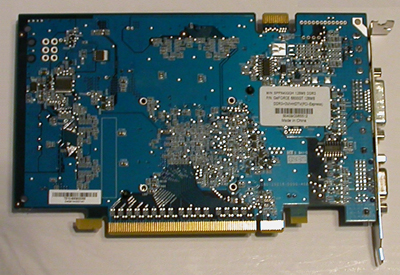Sparkle
Sparkle is using the reference NVIDIA HSF, which in this case, wins a great deal of points. The NVIDIA reference cooling solution has rubber nubs around all four corners of the HSF solution. This adds stability to the part that many other cards in this review lack. Unfortunately, the spring tension isn't wonderfully high, so cooling is a little lower than what might be desired. The spacers may add stability, but they also make it so that in order to get really good contact for cooling, the part would need to be pressed down harder than it currently is.
There were a couple of vendors who sent us "press samples" that were clocked at non-shipping clock speeds. Sparkle is included in this group, but we've asked them to only send us products that we can buy on the shelves. The part that we have in our labs boots up at 507/550, but we clocked it higher than that, easily.
You have to wonder who made the decision that seven MHz and a tiny bit of memory bandwidth was really worth sending us a press sample when we asked them not to do so. Because of that, we also can't be sure that the components that went into the part weren't binned beforehand - the 2ns DDR3 memory easily hit 610MHz.
Getting 2ns memory to clock that high is obviously not impossible. It can happen by chance (we've seen it before on earlier parts that used it), but we'd rather have no doubts.
At the same time, we asked for shipping parts and this is what we received. We'll report all the information that we have along with the numbers that we get and let the readers make the call.











84 Comments
View All Comments
ChineseDemocracyGNR - Saturday, December 11, 2004 - link
#41, please remember this is a 20 page article, and things were written in a way people can easily read all 20 pages.overclockingoodness - Saturday, December 11, 2004 - link
#41: What do you mean barely readable? You are not some scholor who needs perfect writing in order to understand something. If you don't like it, don't read it.The reason why the review style was like a "quickly-patched email" is because it is a round-up of 11 cards.
The point of a round-up is to cover the positives and negatives of a plethora of similar products at the same time. Since AnandTech has already done extensive 6600 benchmarks, they decided to do quick comparison and be done with it.
Now you which 6600 to go for.
If you don't know how things work, it's better to be quiet.
skunkbuster - Saturday, December 11, 2004 - link
#41 lets see if you can do better thenmrscintilla - Saturday, December 11, 2004 - link
Sorry to say this, but the article Derek wrote was barely readable. It reads more like a quickly-patched email than an edited article. The writing quality has to improve in the future.SleepNoMore - Saturday, December 11, 2004 - link
Thank God XFX offers an AGP version of this card. I am not FORCED to buy a PCI-Express slot motherboard and trash my current system.QuestMGD - Friday, December 10, 2004 - link
MSI heatsink really sucks. I had supicions about the heatsink after I got my MSI card from NewEgg. This article verified it. Since the card isn't in a computer yet, I pulled of the heatsink and sanded it down.I'm not done yet, but after a while it does look like I can get it to fit tightly, it was just a PIA. The mounting springs seem to have been originally designed correctly, the heatsink casting was just crap.
BTW heatsink is just copper colored coating over Aluminum or whatever, that's probably why the casting ended up so poor.
Could anyone e-mail me whether I can use CPU thermal compound on my Graphics Card memory chips, or should I go out and get something else? I've heard mixed opinions regarding this. Thanks.
threeply - Friday, December 10, 2004 - link
I noticed No Evga card was included in the review. Any reason why this card was not included?Momental - Friday, December 10, 2004 - link
Cobbling with your bogus dink is not recommended. See your doctor if condition persists. ;)A really great article. Extremely informative and gives "down and dirty", which I like. I'm in the market for a PCI-e 6600GT (sounds like a new motorcycle from Suzuki) and this article really gives one some serious food for thought rather then just the standard angle of "which one is the fastest and/or cheapest?"
The last thing I want is to have to handle one of these things like it was some sort of rare antiquity from the Ming Dynasty. While I don't do my best imitation of a ferrit on crack inside a case, it's good to know that there is the possibility of damaging the HSF quite easily. Who'd a thought!
ShadowVlican - Friday, December 10, 2004 - link
thanks for the excellent write up Derek, i hope the vendors follow your advice to improve the contact issues with the HSF and GPU, since i won't be purchasing a gfx card with poor design that can be fixed so easilythe leadtek will be on top of my list and likely in my next comp as soon as a64 pci-e motherboards come out
JClimbs - Friday, December 10, 2004 - link
Excellent article, focusing on a few key issues that performance buffs tend to overlook in their quest for higher framerates.My overall take after reading this was that the 6600GT's market is really limited to people/companies willing to pull things apart and fix them up right. The cooling solutions all seem either bogus or cobbled, with cobbled being the best of the bunch. If you don't want to dink with your purchase, get a cobbled one; if you WILL dink with it, you can get a bogus model and fix it.
One thing I would like to have seen compared is power usage. I'm curious to see what the spread is there. And also, harking back to an earlier article, if improving the power supply improves overclocking performance.
Once again, excellent article, Derek!